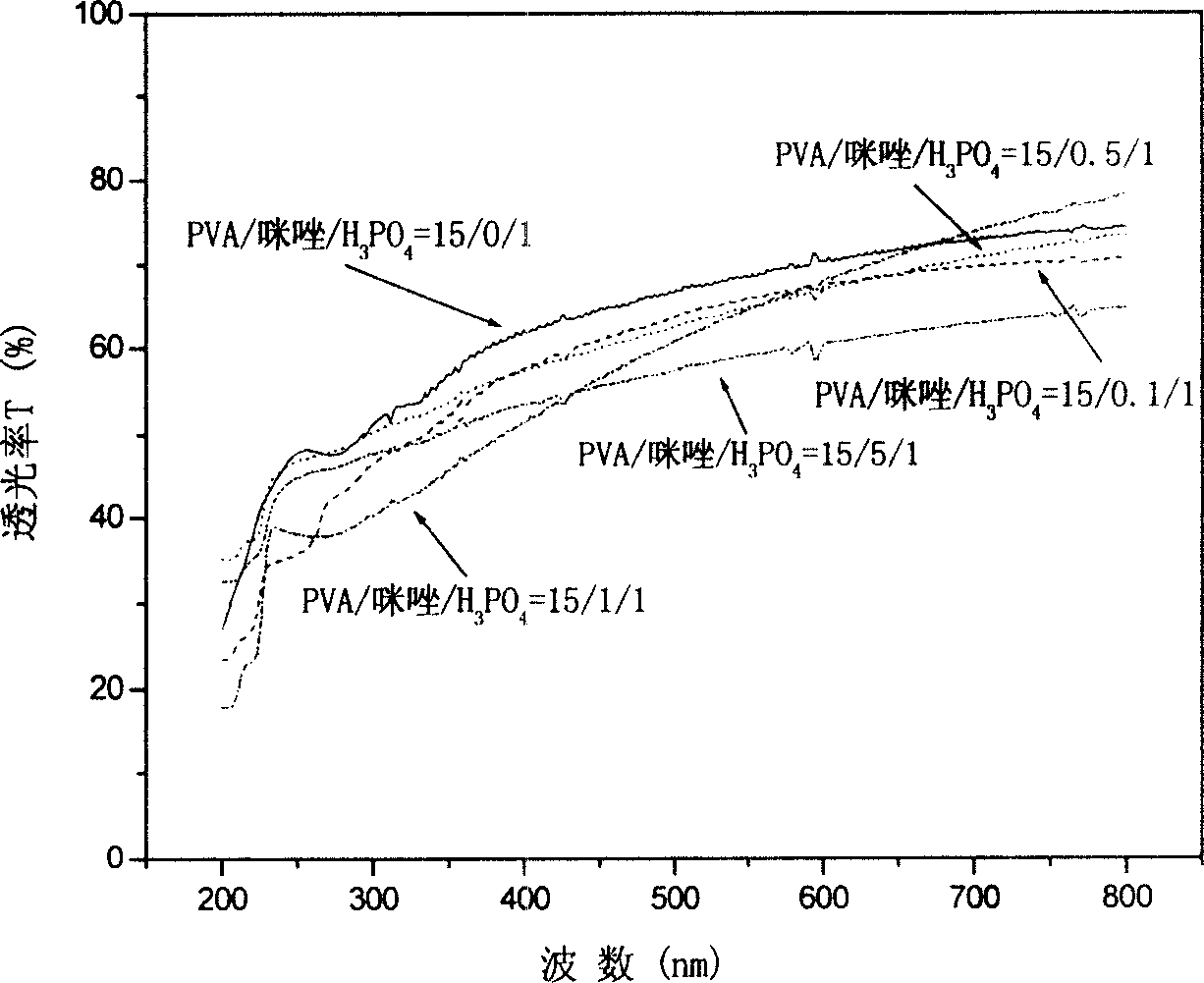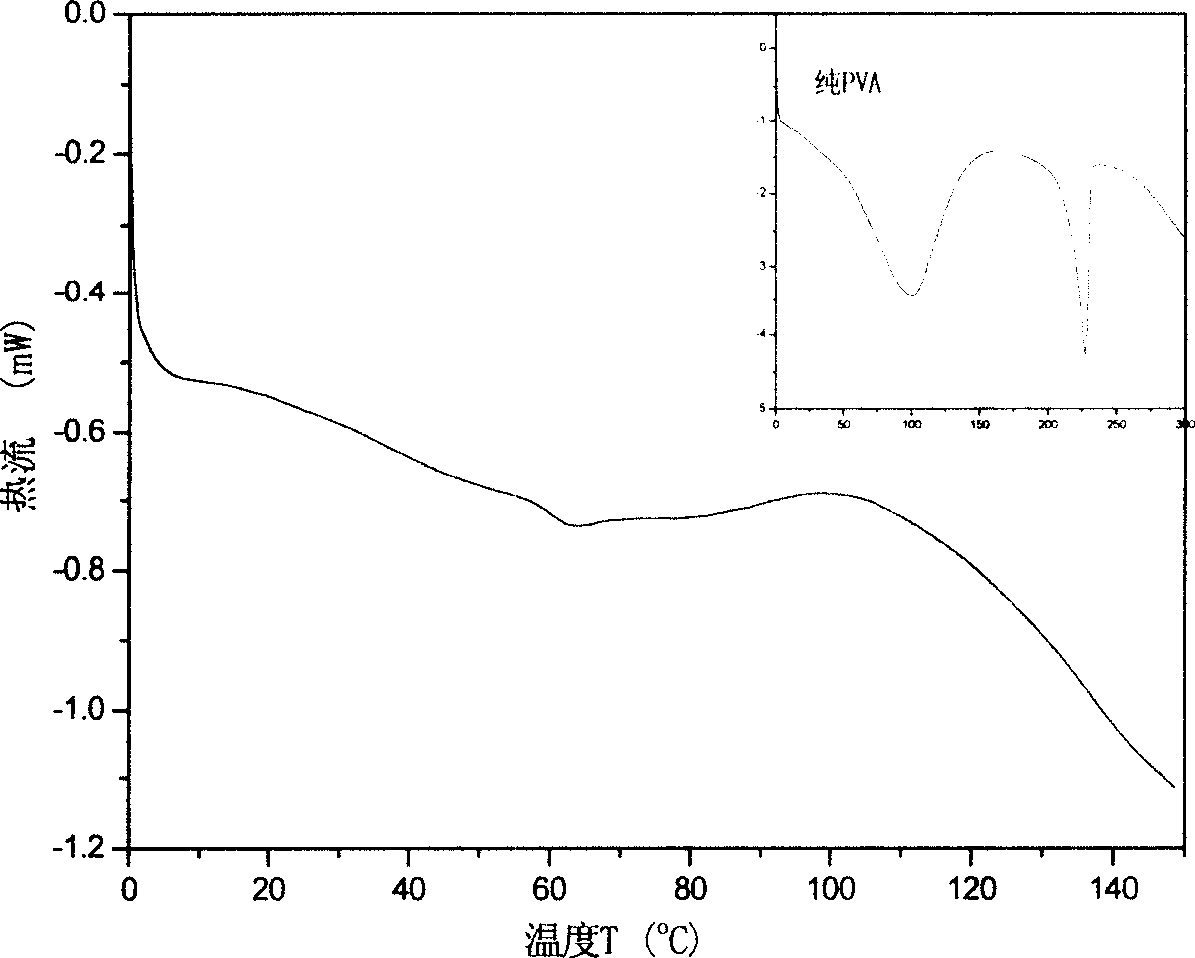Transparent polymer non-aqueous proton conducting material and its preparing method
A transparent polymer, proton-conducting technology, applied in the field of polymer materials and electrochemical materials
- Summary
- Abstract
- Description
- Claims
- Application Information
AI Technical Summary
Problems solved by technology
Method used
Image
Examples
Embodiment 1
[0020] The raw materials used are as follows:
[0021] Polyvinyl alcohol, the number average molecular weight Mn is 17200, the product of Aldrich company.
[0022] Imidazole is a product of Shanghai Runjie Chemical Reagent Co., Ltd.
[0023] 85wt% phosphoric acid, product of Shanghai United Chemical Plant.
[0024] The ratio of raw materials used is as follows:
[0025] Polyvinyl alcohol (MW=17200) 15 parts (number of moles of repeating units)
[0026] 0.5 part of imidazole (number of moles)
[0027] Phosphoric acid 1 part (moles)
[0028] Sample preparation:
[0029] According to the above ratio, phosphoric acid and imidazole were dissolved in deionized water, and stirred at a constant temperature of 90°C for 4 hours to prepare imidazolium phosphate. Dissolve polyvinyl alcohol in deionized water, and stir with a magnetic stirrer at a constant temperature of 100°C until the PVA is completely dissolved to obtain a transparent and uniform viscous li...
Embodiment 2
[0035] The ratio of raw materials used is as follows:
[0036] 15 parts of polyvinyl alcohol (Mn=17200) (number of moles of repeating units)
[0037] 1 part of pyrazole (number of moles)
[0038] Phosphoric acid 1 part (moles)
[0039] Dissolve polyvinyl alcohol and phosphoric acid in deionized water according to the above ratio, stir at a constant temperature of 100°C for 4 hours, mix evenly, and form a film on the polytetrafluoroethylene board by casting the solution, and dry it in vacuum , that is, an all-solid-state PYA / pyrazole / phosphoric acid composite proton-conducting membrane. The proton conductivity and light transmission properties of the obtained composite film are as follows: figure 1 and figure 2 shown.
Embodiment 3
[0041] The ratio of raw materials used is as follows:
[0042] 15 parts of polyvinyl alcohol (Mn=17200) (number of moles of repeating units)
[0043] 1 part of imidazole (number of moles)
[0044] Phosphoric acid 1 part (moles)
[0045] Dissolve polyvinyl alcohol, phosphoric acid and imidazole in deionized water according to the above ratio, stir at a constant temperature of 100°C for 4 hours, mix evenly, and form a film on the polytetrafluoroethylene plate by casting the solution, vacuum After drying, a fully homogeneous PVA / imidazole / phosphoric acid composite proton-conducting membrane can be obtained. The proton conductivity and light transmission properties of the obtained composite film are as follows: figure 1 and figure 2 shown.
PUM
| Property | Measurement | Unit |
|---|---|---|
| glass transition temperature | aaaaa | aaaaa |
Abstract
Description
Claims
Application Information
 Login to View More
Login to View More - R&D
- Intellectual Property
- Life Sciences
- Materials
- Tech Scout
- Unparalleled Data Quality
- Higher Quality Content
- 60% Fewer Hallucinations
Browse by: Latest US Patents, China's latest patents, Technical Efficacy Thesaurus, Application Domain, Technology Topic, Popular Technical Reports.
© 2025 PatSnap. All rights reserved.Legal|Privacy policy|Modern Slavery Act Transparency Statement|Sitemap|About US| Contact US: help@patsnap.com



